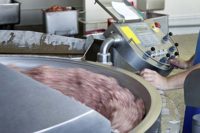Increase clean-in-place system efficiency by following these guidelines.
Food, water and time. For decades, students taking basic food microbiology courses have been taught that these factors - commonly depicted by colorful, interconnected circles in text books (see diagram on p. 51) - can promote the growth of harmful microorganisms in the processing environment if they are not properly controlled.
In the early 1950s, systems of assembled equipment that could be cleaned and sanitized without dismantling, called clean-in-place (CIP) systems, first were introduced in the dairy industry to diminish the synergistic relationship of food, water and time, and to compensate for nationwide metal shortages caused by World War II. While it is now difficult to envision, before the advent of CIP equipment, dairy processing equipment was completely taken down each day, cleaned manually and left to dry overnight.
Simply put, CIP technology uses chemical cleaning solutions to remove soils and contaminants such as allergenic ingredients from interconnected piping, vats, conveyor belts, heat exchangers, etc., and is widely employed throughout the food, beverage, and pharmaceutical industries. CIP systems usually are controlled automatically and cleaning cycles - rinsing, washing, sanitizing and drying - are given optimum timing to ensure efficient cleaning of all parts.
Today, single-use and reuse comprise the two major types of CIP systems. The single-use system discards all liquids to the drain after use, whereas reuse systems store cleaning waters for reuse in subsequent cleaning cycles. Commonly cited advantages of CIP systems in scientific literature include:
• Reduced labor and improved safety;
• Conservation of cleaning solutions through automation;
• Improved equipment and storage utilization;
• Optimization of detergent and water use;
• Access to difficult to clean areas;
• Elimination of equipment reassembly after cleaning;
• Reduced disassembly, maintenance and repair costs.
CIP technology has grown significantly in sophistication and scope over time (i.e. micro-processor-controlled automatic units), but the underpinnings of this technology - reduced manual intervention, improved cleaning consistency and increased production time - essentially have remained the same.
Like many modern and advanced technologies from every walk of industry, CIP systems are most effective and efficient when guidelines for optimal performance are strictly followed. What follows is a short checklist of CIP best practices to help food processors achieve utmost performance from their investment and ensure end-use products meet safety and quality standards.
1. Right combination
Generally, the installation and maintenance of custom-designed CIP systems require a considerable financial investment. To protect this business asset, it is imperative for companies to adhere to prescribed guidelines for: 1) selection of chemical solutions for specified soil/contaminant removal; 2) concentration levels for chemicals; 3) time exposure and temperature for cleaning solutions; and 4) appropriate cleaning pressure levels for systems.
Responsive equipment and chemical suppliers are invaluable resources to maximize the effectiveness and efficiency of CIP systems. As such, these experts should be consulted to troubleshoot issues related to poor quality performance and incorporate corrective measures as needed.
2. Trained and qualified personnel
Highly trained and qualified employees are integral to the effectiveness of CIP equipment. Ideally, equipment operators should possess a basic understanding of the mechanical, electrical and operational principles of CIP equipment. This indispensable knowledge is necessary to help personnel avoid miscues and red flag dynamics that could signal microbial growth risks.
For example, gaskets often become worn and gradually lose their elastic properties. When over-tightened by personnel, gaskets can extrude into pipelines and product flow paths, leaving small dents that can harbor microorganisms and subsequently lead to the formation of biofilms. Both pathogens and spoilage organisms have been reported to form biofilms, and currently there are no sanitizers registered with the U.S. Environmental Protection Agency to remove them.
Employee training programs should be organized and structured to provide attendees with useful information on basic food microbiology and the equipment they work with on a daily basis. CIP manufacturers, chemical suppliers and private consulting organizations can assist companies in the development and implementation of education initiatives. Independent studies have shown that well-trained employees are integral to successful sanitation programs.
3. Cleaning inspection
Despite their superior ease of cleaning, CIP systems still should be inspected regularly to ensure optimal cleaning occurs. Periodically, equipment should be broken down allowing technicians to sample inner product surfaces for residues and contamination.
Technicians should apply aseptic sampling techniques to ensure the integrity of samples for microbiological testing.
Documentation verifying that critical parameters (i.e. time, temperature, cleaning agent concentration, etc.) are achieved with each cleaning cycle should be maintained in written standard operating procedures.
4. Art of design
Plant shutdowns, product recalls, lost revenue and negative publicity are just a few of the consequences companies may suffer when contaminated products are released to the public. Time and again, experience has shown us that improperly designed and unhygienic equipment are at the origin of many costly contamination problems.
When designing a custom CIP system, special factors must always be taken into consideration to minimize opportunities for microbial growth. To this end, it is imperative for companies to work closely with reputable CIP equipment manufacturers, chemical suppliers and outside consulting firms to achieve their objectives.
In accordance with regulatory guidelines, cleaning validation studies must be conducted to verify the efficacy of CIP equipment (removal of residues, effectiveness of cleaning agents, degradation of products, control of potential microbial contaminants, etc.) under “worst-case” scenarios. A number of third-party, scientific organizations can assist food and beverage manufacturers with these critical evaluations.
Editor’s note: With locations worldwide, Silliker is an international network of food testing and consulting laboratories. Dr. Gustavo Gonzalez and John Williams Jr. are education manager and senior communications specialist, respectively, at the company’s Homewood, Ill., headquarters. Contact them at info@silliker.com.


